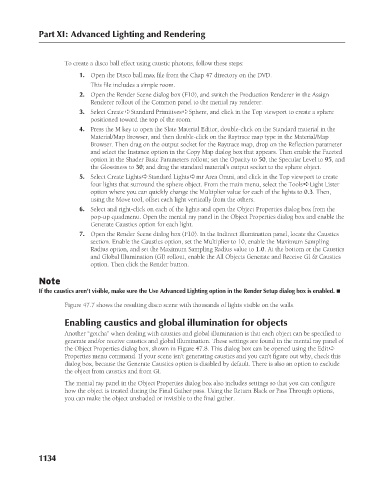Page 1182 - Kitab3DsMax
P. 1182
Part XI: Advanced Lighting and Rendering
To create a disco ball effect using caustic photons, follow these steps:
1. Open the Disco ball.max file from the Chap 47 directory on the DVD.
This file includes a simple room.
2. Open the Render Scene dialog box (F10), and switch the Production Renderer in the Assign
Renderer rollout of the Common panel to the mental ray renderer.
3. Select Create ➪ Standard Primitives ➪ Sphere, and click in the Top viewport to create a sphere
positioned toward the top of the room.
4. Press the M key to open the Slate Material Editor, double-click on the Standard material in the
Material/Map Browser, and then double-click on the Raytrace map type in the Material/Map
Browser. Then drag on the output socket for the Raytrace map, drop on the Reflection parameter
and select the Instance option in the Copy Map dialog box that appears. Then enable the Faceted
option in the Shader Basic Parameters rollout; set the Opacity to 50, the Specular Level to 95, and
the Glossiness to 30; and drag the standard material’s output socket to the sphere object.
5. Select Create Lights ➪ Standard Lights ➪ mr Area Omni, and click in the Top viewport to create
four lights that surround the sphere object. From the main menu, select the Tools ➪ Light Lister
option where you can quickly change the Multiplier value for each of the lights to 0.3. Then,
using the Move tool, offset each light vertically from the others.
6. Select and right-click on each of the lights and open the Object Properties dialog box from the
pop-up quadmenu. Open the mental ray panel in the Object Properties dialog box and enable the
Generate Caustics option for each light.
7. Open the Render Scene dialog box (F10). In the Indirect Illumination panel, locate the Caustics
section. Enable the Caustics option, set the Multiplier to 10, enable the Maximum Sampling
Radius option, and set the Maximum Sampling Radius value to 1.0. At the bottom or the Caustics
and Global Illumination (GI) rollout, enable the All Objects Generate and Receive GI & Caustics
option. Then click the Render button.
Note
If the caustics aren’t visible, make sure the Use Advanced Lighting option in the Render Setup dialog box is enabled. n
Figure 47.7 shows the resulting disco scene with thousands of lights visible on the walls.
Enabling caustics and global illumination for objects
Another “gotcha” when dealing with caustics and global illumination is that each object can be specified to
generate and/or receive caustics and global illumination. These settings are found in the mental ray panel of
the Object Properties dialog box, shown in Figure 47.8. This dialog box can be opened using the Edit ➪
Properties menu command. If your scene isn’t generating caustics and you can’t figure out why, check this
dialog box, because the Generate Caustics option is disabled by default. There is also an option to exclude
the object from caustics and from GI.
The mental ray panel in the Object Properties dialog box also includes settings so that you can configure
how the object is treated during the Final Gather pass. Using the Return Black or Pass Through options,
you can make the object unshaded or invisible to the final gather.
1134

